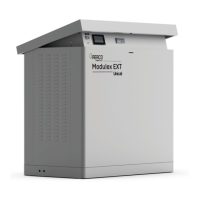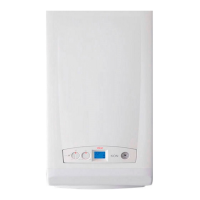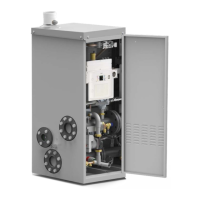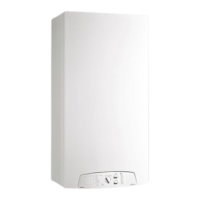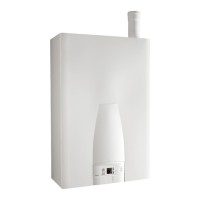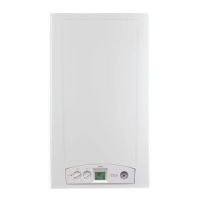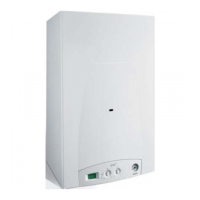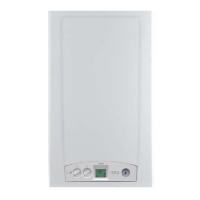20
2.4.1 - GENERAL DESCRIPTION
When there is an heat request from a
room thermostat or an outer compensa-
tor, the Modular Boiler Drive (MBD) cal-
culates the necessary output according
to the difference between the set tempe-
rature (or the temperature calculated by
the outer compensator) and the global
flow temperature. The number of thermal
elements (each thermal element repre-
sents a maximum output of 90 kW) x
100% determines the maximum output
expressed in %.
When the output has been determined, the
boiler pump (not supplied by Unical) is set
up and the fan of one thermal element is
set in motion at starting speed. The gas
valve opens and ignition is to occur with-
in 5 sec. When the ionisation electrode
detects the flame, the thermal element
starts operating.
Subsequently other thermal elements are
likely to start in the same way. One of the
operation principles for this boiler is let-
ting as many burners as possible oper-
ate simultaneously at minimum load to
reach the maximum efficiency.
For example, if a 4 thermal element boiler
is requested to operate at its max output,
this shall be 400% i.e. :
90 kW x 4 thermal elements =
360 kW = 400%.
If it is requested to operate at 200% out-
put, thanks to the output sharing system
on the highest number of thermal ele-
ments, each thermal element will operate
at 50% output i.e. :
200% : 4 thermal elements = 50%
equal to a total of 180 kW, that is 45 kW
for each thermal element.
1 Thermal element = 90 kW = 100%
4 Thermal elem. = 90 kW x 4 = 360 kW = 400%
400% : 360kW = 200% : X
X = (200x360) : 400 = 180 kW
output shared on 4 thermal elements
Output shared on 4 thermal elements : total output
= 180:360 = 0,5 = 50%
Such principle provides clearly efficien-
cies much higher than those obtained in
traditional groups of small boilers installed
in cascade.
When the output shared on each thermal
element is less than 22 kW, one thermal
element after the other is automatically
excluded and the remaining output is
shared on thermal elements having the
smallest number of operation hours (by
the automatic operation-time calculating
system).
Modulation, i.e. output reduction, is based
on the difference between the set temper-
ature (or the temperature calculated by
the outer compensator) and the global
flow temperature.
When no ignition occurs, the ignition de-
vice puts to lock out position the thermal
element concerned.
Efficiency of a thermal element working at full capacity
(90 kW) = 103 % (in condensation)
Efficiency of a thermal element working at reduced capacity
(45 kW) = 107 % (in condesation)
Efficiency of a thermal element working at minimum capacity
(22 kW) = 109 % (in condesation)
All the thermal elements work in parallel at the same output, equalizing,
thus, the C.H. system efficiency to the one of the thermal element.
0
5
10
15
20
25
30
35
40
kW
mod 1
45
50
55
60
65
70
75
80
85
90
4 thermal elements of 90 kW each working
at 50% of the output give = 180 kW = (200%),
i.e. 45 kW / thermal element
% (p.c.i.)
P
(kW)
20
105
109
40 8060
107
100 % = 90 kW
50 % = 45 kW
90
45
22
1 thermal
element
1 thermal
element
